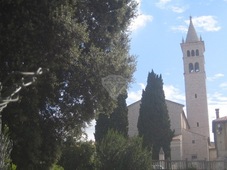to enlarge


or choose the place
from the menu below
 Rome |
 Byzantium |
 Venice |
 Vienna |
 Brioni |
 Smrikve |
 |
 |
As mentioned above, through the centuries the Arena served as a kind of quarry from which materials were taken to erect churches and other buildings in both Pula and Venice. This activity was forbidden for many centuries but the devastation continued.
The monumental stone exterior of the Arena is rhythmically divided with two storeys. The second storey has 70 identical arcades in each row, while the two larger arcades are placed in the longest part of the Arena. In total the Arena has 104 arcades. Also the topmost third storey with its 64 rectangular openings has been preserved.
Vertical grooves are visible on the inner side of the walls. Wooden masts were placed in these grooves during summer events to support the awning roof of the amphitheatre - called velarium - to protect spectators from the elements.
Another specific feature of the Arena are the four stone towers leaning on the outer side of the building’s walls. These towers had wooden stairways that helped to enter and exit from the Arena. At the time the Arena had about 15-20 spectator entranceways.
As written earlier the Romans spread fragrant water inside the Arena and protected spectators from the sun.
The stairs we see now in the Arena were rebuilt during the Fascist period between the two World Wars. There is a permanent exhibit in the underground section of the Arena that is worth visiting – “Olive and Wine - Growing of Istria in Antiquity”. The Arena also had a system of elevators from where the gladiators and wild animals were taken into the Arena.
Over the last three centuries the Arena has been restored several times. The first works were done by Gian Rinaldo Carli from Kopar. Later on, in 1810, the Napoleon Marshal Marmont helped restore the Arena to its old beauty.
In 1816 Pietro Nobile completed external restorations under the order of the Austro-Hungarian Emperor Francisco I. In 1935, during the Fascist period, the current stairs were built and three years prior the Arena had started to be used for lyrical shows.
It is interesting that the place once built for gladiators now hosts numerous cultural events. The most important are: Histria Festival and Pula’s Film Festival.
During the summer and the Histria Festival the Arena hosts concerts of World famous singers like: Zucchero, Norah Jones, Eros Ramazzotti, Anastasia, Joe Coker, Sting, Placido Domingo, Jose Carreras, Jamiroquai,… or you can also enjoy an Opera or a classical concert, like being in Verona’s famous Amphitheatre.
Luciano Pavarotti was a guest of the Arena several times. Every year there is a surprise about who will be hosted in this magnificent historical building.
If you are in Smrikve in July during the week of the Film Festival you should try to experience the “cinema under the stars”.
Pula’s Film Festival has a history of over five decades and during the former Yugoslavian period it was a mega event with the highest quality films in this region of Europe.
 Currently the Festival is a must for all
film lovers who are interested in the latest Croatian films and other attractive international film productions. Today Croatia
has almost thirty film festivals a year but all of these events are a long way from what I remember Pula’s film festival
was like, when I was a kid.
Currently the Festival is a must for all
film lovers who are interested in the latest Croatian films and other attractive international film productions. Today Croatia
has almost thirty film festivals a year but all of these events are a long way from what I remember Pula’s film festival
was like, when I was a kid.
Above the Arena you will note a white bell tower. This is the Church of St. Anthony from Padua that was built in 1931. Its bell tower was built three years later in 1934.
If you go back to the front of the Arena and take the street that passes near Karolina’s parking area towards the old town, on Karolina’s parking lot you will notice a big building that dates back to 1832. This was the place of the Roman water fountain and was used during the Roman period to supply water to the town. It was named “Ninfeo” at the time.
n front of the Arena you will also find a information board describing both the Arena and the old Roman well.